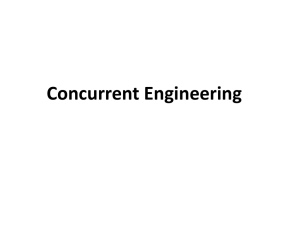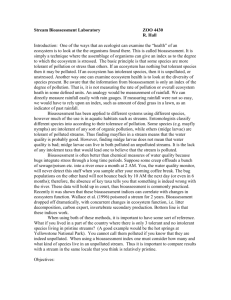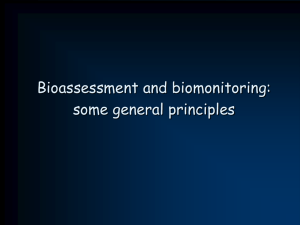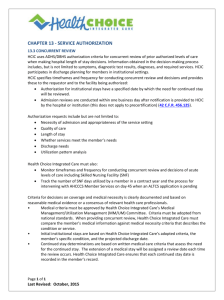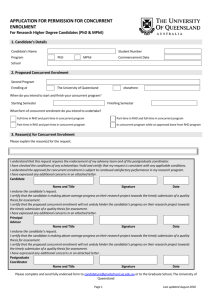Initial Monitoring Strategy - Des Plaines River Watershed Workgroup
advertisement
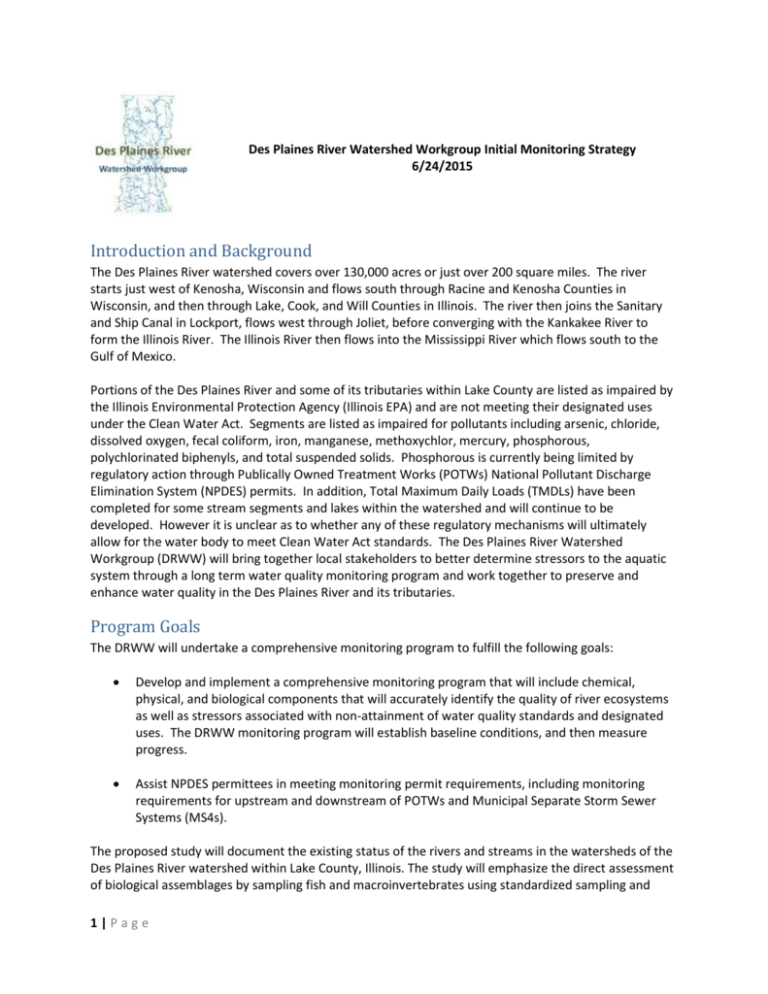
Des Plaines River Watershed Workgroup Initial Monitoring Strategy 6/24/2015 Introduction and Background The Des Plaines River watershed covers over 130,000 acres or just over 200 square miles. The river starts just west of Kenosha, Wisconsin and flows south through Racine and Kenosha Counties in Wisconsin, and then through Lake, Cook, and Will Counties in Illinois. The river then joins the Sanitary and Ship Canal in Lockport, flows west through Joliet, before converging with the Kankakee River to form the Illinois River. The Illinois River then flows into the Mississippi River which flows south to the Gulf of Mexico. Portions of the Des Plaines River and some of its tributaries within Lake County are listed as impaired by the Illinois Environmental Protection Agency (Illinois EPA) and are not meeting their designated uses under the Clean Water Act. Segments are listed as impaired for pollutants including arsenic, chloride, dissolved oxygen, fecal coliform, iron, manganese, methoxychlor, mercury, phosphorous, polychlorinated biphenyls, and total suspended solids. Phosphorous is currently being limited by regulatory action through Publically Owned Treatment Works (POTWs) National Pollutant Discharge Elimination System (NPDES) permits. In addition, Total Maximum Daily Loads (TMDLs) have been completed for some stream segments and lakes within the watershed and will continue to be developed. However it is unclear as to whether any of these regulatory mechanisms will ultimately allow for the water body to meet Clean Water Act standards. The Des Plaines River Watershed Workgroup (DRWW) will bring together local stakeholders to better determine stressors to the aquatic system through a long term water quality monitoring program and work together to preserve and enhance water quality in the Des Plaines River and its tributaries. Program Goals The DRWW will undertake a comprehensive monitoring program to fulfill the following goals: Develop and implement a comprehensive monitoring program that will include chemical, physical, and biological components that will accurately identify the quality of river ecosystems as well as stressors associated with non-attainment of water quality standards and designated uses. The DRWW monitoring program will establish baseline conditions, and then measure progress. Assist NPDES permittees in meeting monitoring permit requirements, including monitoring requirements for upstream and downstream of POTWs and Municipal Separate Storm Sewer Systems (MS4s). The proposed study will document the existing status of the rivers and streams in the watersheds of the Des Plaines River watershed within Lake County, Illinois. The study will emphasize the direct assessment of biological assemblages by sampling fish and macroinvertebrates using standardized sampling and 1|Page assessment methodologies. In addition to determining aquatic life status, the project will also ascertain the associated causes and sources associated with biological impairments by using paired chemical, physical, and other stressor data and information within a systematic analytical process detailed in a comprehensive plan of study. Budget The DRWW will use annual membership dues to support the comprehensive monitoring program. Qualified contractors will be secured through a competitive bid process. Preliminary annual budget: Annual dues: $225,000 o $50,000 Administration o $175,000 Monitoring Program Bioassessment and habitat: $75,000 Water column and sediment chemistry: $75,000 Analysis and reporting: $25,000 Monitoring Plan The monitoring program consists of two components at 45 sites throughout the Des Plaines River watershed within Illinois. The bioassessment program, consisting of monitoring fish, macroinvertebrates, and habitat, will be completed on an annual rotating basis with a subset of sites being completed each year, dependent on cost and available funds. Sediment chemistry will be conducted concurrently with bioassessment sites. Water column chemistry monitoring will be completed annually with a tiered site design. The monitoring design and protocol is modeled after the DuPage River Salt Creek Workgroup and the Lower DuPage River Watershed Coalition (Yoder 2012). Monitoring Sites Monitoring sites are located on the main stem, tributaries, and within the headwaters, as shown in Figure 1 and Table 1. POTWs are bracketed to determine to what effect effluent impacts the receiving waters. Sites are also located to determine the influences of tributary streams and other features, for example, the impact of online lakes. Water Column and Sediment Chemistry Monitoring Water column chemistry will be monitored using a tiered site design to allow for more frequent monitoring of sites with greater flow and tributary area while still allowing for comprehensive coverage of the watershed. Samples will be collected using grab samples upstream of the monitoring station unless otherwise noted in site description maps. Table 2 shows the parameters and summarizes the frequency of sampling described below for water column and sediment chemistry monitoring. Tier 1: 11 sites located on the mainstem Des Plaines River and Mill Creek, monthly May through September and in November and March monitored (seven times per year) for all demand, nutrient, and bacteria parameters; annually under low flow conditions for water column metals, water organics, and once every f years concurrent with the bioassessment for sediment metals and sediment organics. Tier 2: 11 sites located on the Des Plaines and tributary streams for water and sediment chemistry will occur monthly from May through September and in November and March (seven times per year) for the majority of demand, nutrient, and bacteria parameters; annually under low flow conditions for water column metals, water organics, and once every three years concurrent with the bioassessment for sediment metals and sediment organics. 2|Page Tier 3: 23 stream stations located on the Des Plaines and tributary streams within the watershed for water and sediment chemistry will occur monthly from May through September and in November and March (seven times per year) for the majority of demand, nutrient, and bacteria parameters and once every three years concurrent with the bioassessment for sediment metals and sediment organics. Bioassessment The bioassessment will be conducted on a rotating basis, monitoring fish and macroinvertebrate assemblages, habitat, and sediment chemistry with one-third of the stations sampled each year. Biological sampling for fish and macroinvertebrate assemblage data, habitat, and sediment chemistry should follow established protocols of the Illinois Department of Natural Resources (Illinois DNR; 2001) and Illinois EPA (1997, 2005) and be capable of producing comparable data and assessments. Sampling methods will be determined based on whether the stream is non-wadeable or wadeable. Ultimately methods will be determined by the contractor and documented in the Quality Assurance Project Plan (QAPP). Quality Assurance Project Plan All monitoring will be conducted under an Illinois EPA approved QAPP. The DRWW will use the DuPage River Salt Creek Workgroup’s (DRSCW) approved QAPP and adapt it to be watershed specific. Illinois EPA requires the development of a QAPP for any activity involving the collection and analysis of environmental data. A QAPP presents the policies and procedures, organization, objectives, quality assurance requirements, and quality control activities designed to achieve the type and quality of environmental data necessary to support project or program objectives. It is the policy of Illinois EPA that no data collection or analyses will occur without an approved QAPP. All in-house and external environmental data collection activities are subject to this requirement. All contracts must address quality assurance requirements (e.g., data quality and reporting requirements) when those contracts pertain to, or have an impact on, data collection or analysis activities. Additionally, all grants and contracts need to address quality assurance requirements specified in applicable state acquisition or procurement regulations. The DRWW QAPP will follow U.S. guidance for the development of a project specific QAPP. References Illinois DNR. 2001. IDNR stream fisheries sampling guidelines. Watershed Protection Section, Springfield, IL. 9 pp. Illinois EPA. 2005. Methods of collecting macroinvertebrates in streams (July 11, 2005 draft). Bureau of Water, Springfield IL. BOW No. xxxx. 6 pp. Illinois EPA. 1997. Quality assurance methods manual. Section G: Procedures for fish sampling, electrofishing safety, and fish contaminant methods. Bureau of Water, Springfield, IL. 39 pp. Yoder, C.O. 2012. Quality Assurance Project Plan: Biological and Habitat Assessment of the DuPage River and Salt Watersheds. 3|Page Figure 1: Water Quality Sampling Locations 4|Page Table 1: Water Quality Sampling Locations Des Plaines River Sample Locations Street Upper Des Plaines Russell Rd Highway 173 Wadsworth Rd Above Highway 41 McClure Ave Highway 120 Rockland Rd CN Railroad Highway 60 Half Day Rd Deerfield Rd Lake Cook Rd Willow Rd Bull's Brook @ Route 21 Belvidere Rd Tributary @ Highway 21 and 120 Stoneroller @ Lake Carina Suburban Country Club Tributary @ Shirley Dr Slocum Corners Creek @ Mill Creek Rd Newport Drainage Ditch @ Kilbourne Ave Milburn Rd Kelly Rd Route 173 Miller Rd Grass Lake Rd Dilley's Rd Hunt Club Rd Stearns School Rd Route 45 Washington St Wick St Bull Creek @ Route 21 Route 137 Marriot Lincolnshire Grounds Sullivan Wood Preserve, North of Creek View Dr Greggs Parkway Port Clinton Rd @ Kildeer Creek Oak Wood Rd Washitay Ave Salem Lake Dr Pekara Rd Aspen Rd Lake Cook Rd @ Farington Ditch Checker Lake Cook Rd @ Buffalo Creek Tributary A Route 21 Total Lower Des Plaines Upper Des Plaines Tributaries Newport North Mill Mill Creek Bull Creek Indian Creek Aptakisic Buffalo Creek 5|Page Station ID 13-6 13-5 13-4 13-3 13-2 13-1 16-7 16-6 16-5 16-4 16-3 16-2 16-1 13-7 13-8 13-9 13-10 13-11 12-1 10-1 10-2 10-3 10-4 10-5 11-1 11-2 11-3 11-4 11-5 11-6 14-1 14-2 15-1 15-2 15-3 15-4 15-5 15-6 15-7 18-2 18-1 17-2 17-3 17-4 17-1 Bioassessment Tier Designation 1 2 2 1 1 1 3 1 1 1 1 1 1 3 3 3 3 3 3 3 3 2 2 3 1 2 3 3 3 3 2 3 2 2 3 3 3 3 3 3 2 3 3 2 2 11 11 23 Table 2: Water Quality Sampling Parameters Parameter Demand Chloride Conductivity pH TOC Sulfate TSS Volatile Suspended Solids DO Temperature Turbidity Metals Total Hardness Iron Sodium Arsenic Manganese Mercury Copper Nickel Zinc Nutrients Ammonia Total Nitrates (NO2 + NO3) TKN Total phosphorus Dissolved reactive phosphorus Bacteria E. coli Water Organics PCBs Pesticides Methoxychlor PNAs VOCs Sediment Metals Aluminum Arsenic Barium Beryllium Boron Cadmium Chromium Cobalt 6|Page DRWW Frequency monthly May-Sept, Nov, Mar monthly May-Sept, Nov, Mar monthly May-Sept, Nov, Mar monthly May-Sept, Nov, Mar monthly May-Sept, Nov, Mar monthly May-Sept, Nov, Mar monthly May-Sept, Nov, Mar monthly May-Sept, Nov, Mar monthly May-Sept, Nov, Mar monthly May-Sept, Nov, Mar Tier 1 Tier 2 Tier 3 Number of Sample Events 7 7 7 7 7 7 7 7 7 7 0 0 7 0 0 7 7 0 7 7 0 7 7 7 7 7 7 7 7 7 annually under low flow conditions annually under low flow conditions annually under low flow conditions annually under low flow conditions annually under low flow conditions annually under low flow conditions annually under low flow conditions annually under low flow conditions annually under low flow conditions 1 1 1 1 1 1 1 1 1 1 0 0 0 1 0 0 0 0 0 0 0 0 0 0 0 0 0 monthly May-Sept, Nov, Mar monthly May-Sept, Nov, Mar monthly May-Sept, Nov, Mar monthly May-Sept, Nov, Mar monthly May-Sept, Nov, Mar 7 7 7 7 7 7 7 7 7 7 0 7 0 7 0 monthly May-Sept, Nov, Mar 7 7 7 annually under low flow conditions annually under low flow conditions annually under low flow conditions annually under low flow conditions annually under low flow conditions 1 1 1 1 1 0 0 0 0 0 0 0 0 0 0 concurrent w/ bioassessment concurrent w/ bioassessment concurrent w/ bioassessment concurrent w/ bioassessment concurrent w/ bioassessment concurrent w/ bioassessment concurrent w/ bioassessment concurrent w/ bioassessment 1 1 1 1 1 1 1 1 1 1 1 1 1 1 1 1 1 1 1 1 1 1 1 1 Table 2 (cont.): Water Quality Sampling Parameters Parameter Sediment Metals Copper Fluoride Iron Lead Manganese Mercury Nickel Potassium Silver Sodium Strontium Vanadium Zinc Sediment Organics PCBs Pesticides Methoxychlor PNAs VOCs TKN Phosphorus Cyanide Herbicides (2, 4, D, 2,4,5 TP) Phenols 7|Page DRWW Frequency concurrent w/ bioassessment concurrent w/ bioassessment concurrent w/ bioassessment concurrent w/ bioassessment concurrent w/ bioassessment concurrent w/ bioassessment concurrent w/ bioassessment concurrent w/ bioassessment concurrent w/ bioassessment concurrent w/ bioassessment concurrent w/ bioassessment concurrent w/ bioassessment concurrent w/ bioassessment concurrent w/ bioassessment concurrent w/ bioassessment concurrent w/ bioassessment concurrent w/ bioassessment concurrent w/ bioassessment concurrent w/ bioassessment concurrent w/ bioassessment concurrent w/ bioassessment concurrent w/ bioassessment concurrent w/ bioassessment Tier 1 Tier 2 Tier 3 Number of Sample Events 1 1 1 1 1 1 1 1 1 1 1 1 1 1 1 1 1 1 1 1 1 1 1 1 1 1 1 1 1 1 1 1 1 1 1 1 1 1 1 1 1 1 1 1 1 1 1 1 1 1 1 1 1 1 1 1 1 1 1 1 1 1 1 1 1 1 1 1 1
